
第10章 Irving’s Bonneville - Chapter 3(2)
And here we would remark a great difference, in point of character and quality, betweenthe two classes of trappers, the "American" and "French," as they are called incontradistinction. The latter is meant to designate the French creole of Canada orLouisiana; the former, the trapper of the old American stock, from Kentucky,Tennessee, and others of the western States. The French trapper is represented as alighter, softer, more self-indulgent kind of man. He must have his Indian wife, his lodge,and his petty conveniences. He is gay and thoughtless, takes little heed of landmarks,depends upon his leaders and companions to think for the common weal, and, if left tohimself, is easily perplexed and lost.
The American trapper stands by himself, and is peerless for the service of thewilderness. Drop him in the midst of a prairie, or in the heart of the mountains, and he isnever at a loss. He notices every landmark; can retrace his route through the mostmonotonous plains, or the most perplexed labyrinths of the mountains; no danger nordifficulty can appal him, and he scorns to complain under any privation. In equipping thetwo kinds of trappers, the Creole and Canadian are apt to prefer the light fusee; theAmerican always grasps his rifle; he despises what he calls the "shot-gun." We givethese estimates on the authority of a trader of long experience, and a foreigner by birth.
"I consider one American," said he, "equal to three Canadians in point of sagacity,aptness at resources, self-dependence, and fearlessness of spirit. In fact, no one cancope with him as a stark tramper of the wilderness."Beside the two classes of trappers just mentioned, Captain Bonneville had enlistedseveral Delaware Indians in his employ, on whose hunting qualifications he placedgreat reliance.
On the 6th of May the travellers passed the last border habitation, and bade a longfarewell to the ease and security of civilization. The buoyant and clamorous spirits withwhich they had commenced their march gradually subsided as they entered upon itsdifficulties. They found the prairies saturated with the heavy cold rains, prevalent incertain seasons of the year in this part of the country, the wagon wheels sank deep inthe mire, the horses were often to the fetlock, and both steed and rider were completelyjaded by the evening of the 12th, when they reached the Kansas River; a fine streamabout three hundred yards wide, entering the Missouri from the south. Though fordablein almost every part at the end of summer and during the autumn, yet it was necessaryto construct a raft for the transportation of the wagons and effects. All this was done inthe course of the following day, and by evening, the whole party arrived at the agencyof the Kansas tribe. This was under the superintendence of General Clarke, brother ofthe celebrated traveller of the same name, who, with Lewis, made the first expeditiondown the waters of the Columbia. He was living like a patriarch, surrounded by laborersand interpreters, all snugly housed, and provided with excellent farms. The functionarynext in consequence to the agent was the blacksmith, a most important, and, indeed,indispensable personage in a frontier community. The Kansas resemble the Osages infeatures, dress, and language; they raise corn and hunt the buffalo, ranging the KansasRiver, and its tributary streams; at the time of the captain's visit, they were at war withthe Pawnees of the Nebraska, or Platte River.
The unusual sight of a train of wagons caused quite a sensation among these savages;who thronged about the caravan, examining everything minutely, and asking athousand questions: exhibiting a degree of excitability, and a lively curiosity totallyopposite to that apathy with which their race is so often reproached.
The personage who most attracted the captain's attention at this place was "WhitePlume," the Kansas chief, and they soon became good friends. White Plume (we arepleased with his chivalrous soubriquet ) inhabited a large stone house, built for himby
order of the American government: but the establishment had not been carried out incorresponding style. It might be palace without, but it was wigwam within; so that,between the stateliness of his mansion and the squalidness of his furniture, the gallantWhite Plume presented some such whimsical incongruity as we see in the galaequipments of an Indian chief on a treaty-making embassy at Washington, who hasbeen generously decked out in cocked hat and military coat, in contrast to his breech-clout andleathern legging; being grand officer at top, and ragged Indian at bottom.
White Plume was so taken with the courtesy of the captain, and pleased with one ortwo presents received from him, that he accompanied him a day's journey on hismarch, and passed a night in his camp, on the margin of a small stream. The method ofencamping generally observed by the captain was as follows: The twenty wagons weredisposed in a square, at the distance of thirty-three feet from each other. In everyinterval there was a mess stationed; and each mess had its fire, where the mencooked, ate, gossiped, and slept. The horses were placed in the centre of the square,with a guard stationed over them at night.